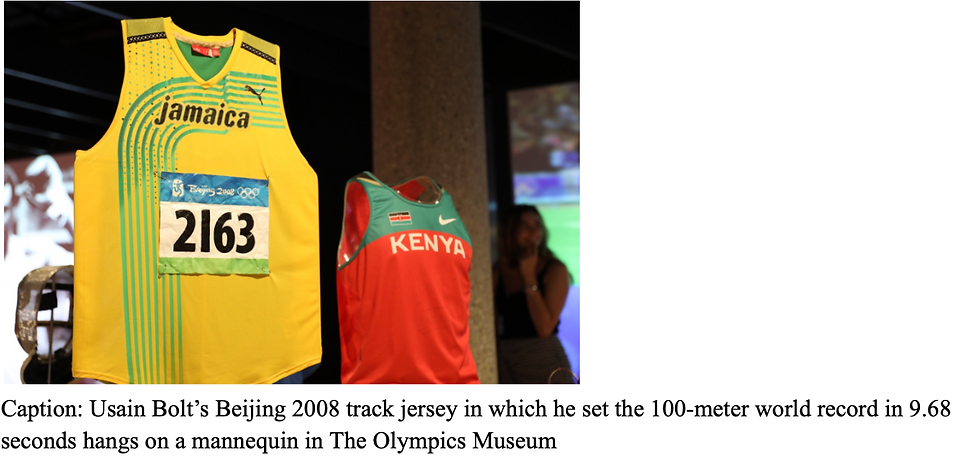Sprint Through Time: The Olympic Museum’s Vast Collection of Artifacts and the Legacy of Track Superstars
- Chandler McIntosh
- Aug 15, 2024
- 4 min read

Caption: The Olympic Museum sign outside on a stone wall in Lausanne, Switzerland
As a child, I was glued to the TV screen, eagerly watching America and Jamaica go head to head in track and field and the U.S. gymnastics team all chasing for gold.
The Olympics represented more than just a series of competitions; they were a source of inspiration and a window into the wider world.
The athleticism of Olympians such as Usain Bolt, Gabby Douglas, and Michael Phelps was mesmerizing, and it was always thrilling to see them push the limits of human strength.
The Olympic Games seemed like a world away from my hometown of Columbia, South Carolina, making witnessing these events in person feel like an unobtainable experience.
This year, however, that distant dream became a reality. Along with 25 students from LSU, I traveled to the Paris Olympics in 2024. The excitement of watching the games in person, surrounded by the electrifying atmosphere, was beyond thrilling.
As the Olympics unfolded, we visited a special place that holds various Olympic artifacts from centuries of unforgettable events, allowing visitors to journey back in time and witness how the Games of the past were held and the athletes who dominated them.

The Olympic Museum, resting on the shores of Lake Geneva in Switzerland, originated from the ideas of Baron Pierre de Coubertin, the International Olympic Committee President from 1896 to 1925 and the inventor of the modern Olympic Games.
During his adolescent years, archaeologists excavated the remains of Olympia, Greece, where Greecians from across the country traveled to compete for glory and to praise their god, Zeus.
The ancient Olympic Games became a staple in Greece and was held every four years in Olympia, Greece for a thousand years. The name “Olympic” also derives from the city in which the games were held.
Roman emperor Constantine’s rule discontinuing the worshiping of false gods and constant natural disasters in Olympia caused the Olympic games to disappear.
The remains of the Grecian Olympics inspired de Coubertin to revive the Olympics with a modern approach, and the first modern Olympics was held in Athens, Greece in 1896.

According to the Perseus Project database, ancient Olympics hosted very few events (chariot racing, running, boxing, etc) with the notion that “only free men who spoke Greek” could compete.

De Coubertin’s modern Olympic Games provided more events for athletes and turned the Olympics into a global competition for women and men. Cities bidding to host the Olympic games were also introduced as part of the modern Olympics; previously the events were always hosted in Olympia, Greece.
To capture past and present history, de Coubertin created “New Olympia”, a museum where historical and modern Olympism came together for audiences to study.
While de Coubertin didn’t witness the final museum, his dreams became a reality when Juan Antonio Samaranch inaugurated The Olympic Museum in 1993.
Hilary Bales, an Olympic Museum tour guide, said that de Coubertin would be ecstatic with The Olympic Museum’s ongoing attractions and historical for visitors from around the world.
“He was all about getting the whole world involved and wanting everyone to come together through sport,” Bales said.
The Olympic Museum is filled with artifacts that transport you back in time, allowing you to relive the moments when athletes were at the peak of their careers and achieved great success.
Two athletes in particular whose Olympic accomplishments left an incredible mark on sports history have donated relics for fans from all ages to admire.

Usain Bolt’s Beijing 2008 track jersey in which he set the 100-meter world record in 9.68 seconds symbolizes the extraordinary ability of the human body to continuously push boundaries, shatter records, and defy the odds in the pursuit of speed.
Standing in front of Usain Bolt’s jersey at the Olympic Museum was a moment that gave me chills, as it felt like stepping back in time when I was a child.
The Jamaica jersey was more than just a piece of fabric; it was a symbol of Bolt’s speed and dominance on the track. Seeing it on display brought back memories of his record-breaking performances and reminded me of the impact he had on the world of athletics.

While Bolt broke records at the 2008 Beijing Olympics, an American 72 years prior defied the odds and overcame significant obstacles to break world records.
Jesse Owens won four gold medals at the 1936 Olympic Games in Berlin, Germany during a time when people of color faced systemic discrimination. Even though Owens was perceived as inferior to the German race, this trailblazer rose above racial barriers.
In the 100 meter, 200 meter, long jump, and 4x 100 meter relay, Jesse Owens captured the gold medal and proved that he was the most successful athlete at the Olympics.
Both Bolt and Owens’ achievements paved the way for future generations of athletes, demonstrating the power of resilience and the fight for equality.
The Olympic Museum prides itself on not just being about collections, but a showing of inspiring stories of individuals from diverse backgrounds who become athletes representing their home countries. The Olympic Museum’s display of items from these two legendary athletes serves as a powerful reminder to future generations that they, too, can change the world—one sprint at a time.
Chandler McIntosh






Comments